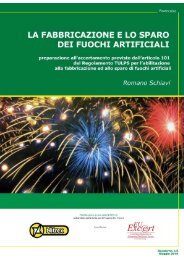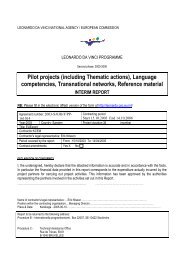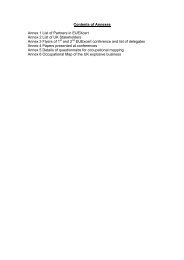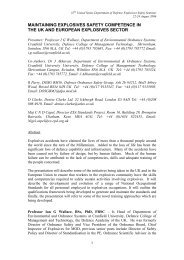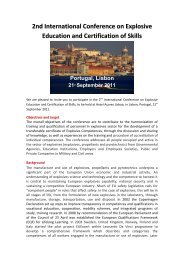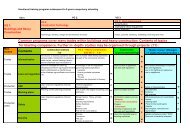SAFEX Newsletter No.35 - EU-Excert
SAFEX Newsletter No.35 - EU-Excert
SAFEX Newsletter No.35 - EU-Excert
You also want an ePaper? Increase the reach of your titles
YUMPU automatically turns print PDFs into web optimized ePapers that Google loves.
<strong>SAFEX</strong> <strong>Newsletter</strong> <strong>No.35</strong>, 4 th Qtr. 2010 12<br />
Our Explosives Regulatory World<br />
Update on the 6 (d) Test<br />
Ben Barrett<br />
Ben Barrett, an Expert Panel member, is an independent consultant specializing in regulation of explosives. DG<br />
Advisor, Ben’s consultancy, is dedicated to participation in the development and modification of international<br />
dangerous goods regulations and helping clients comply with US and international regulations. Ben also provides<br />
training in the handling of dangerous goods including that required by ICAO.<br />
Background<br />
The 6(d) test was adopted in December 2008 by the<br />
UN for the purpose of removing certain products from<br />
Division 1.4 Compatibility Group S classification to<br />
Division 1.4 other than S. It examines addresses part of<br />
the definition of 1.4S that previously was evaluated<br />
using the 6(a) test:<br />
Substance or article so packed or designed that any<br />
hazardous effects arising from accidental<br />
functioning are confined within the package [Note:<br />
6(d) test] unless the package has been degraded by<br />
fire. [Note: 6(c) test].<br />
The 6(d) test method is based on the existing 6(a)<br />
single package test that determines whether inner<br />
packages or articles propagate one to the next when<br />
confined by surrounding material. The 6(d) is different<br />
in that it does not include surrounding material. The<br />
test measures the effects outside the package which<br />
can’t normally be discerned when confined. It was<br />
implemented by adding a special provision requiring<br />
the test for eight out of the approximately 32 existing<br />
1.4S UN numbers, which include the following:<br />
Cartridges, power device, UN 0323<br />
Charges, bursting, plastics bonded, UN 0460<br />
Charges, explosive, commercial without detonator,<br />
UN 0445<br />
Charges, shaped without detonator, UN 0441<br />
Detonator assemblies, non-electric for blasting, UN<br />
0500<br />
Detonators, electric for blasting, UN 0456<br />
Detonators for ammunition, UN 0366<br />
Detonators, non-electric for blasting, UN 0455<br />
The Issues<br />
The implementation of this test is a problem for all<br />
products in these UN numbers because it is retroactive.<br />
Existing products which would clearly pass still have to<br />
undergo the re-approval process. Products which would<br />
fail the test but obviously fit into Division 1.4 must<br />
undergo approval into 1.4 other than S since selfclassification<br />
is not allowed. Until recently the only<br />
impact of the 6(d) test has been for air shipments.<br />
In Spring 2009, the ICAO Technical Instructions for<br />
the Safe Transport of Dangerous Goods by Air were<br />
amended by adding a new paragraph 1.4.2.1:<br />
“1.4.2.1 Certain Division 1.4S explosives,<br />
identified by Special Provision A165 in Table 3-1,<br />
are subject to Test Series 6 (d) of Part I of the UN<br />
Manual of Tests and Criteria (see<br />
ST/SG/AC.10/36/Add.2) to demonstrate that any<br />
hazardous effects arising from functioning are<br />
confined within the package. Evidence of a<br />
hazardous effect outside the package includes:<br />
a) denting or perforation of the witness plate<br />
beneath the package;<br />
b) a flash or flame capable of igniting such as a<br />
sheet of 80 ± 3 g/m2 paper at a distance of 25<br />
cm from the package;<br />
c) disruption of the package causing projection<br />
of the explosives contents; or<br />
d) a projection which passes completely through<br />
the packaging (a projection or fragment<br />
retained or stuck in the wall of the packaging<br />
is considered as non hazardous).<br />
The appropriate national authority may wish to<br />
take into account the expected effect of the<br />
initiator when assessing the results of the test, if<br />
these are expected to be significant when<br />
compared to the articles being tested. If there are<br />
hazardous effects outside the package, then the<br />
product is excluded from Compatibility Group S.”<br />
A new Special Provision A165 was also added by<br />
ICAO:<br />
“A165 This entry must not be used for transport<br />
on passenger aircraft when testing in accordance<br />
with the UN Manual of Tests and Criteria Test<br />
Series 6 (a), upon which classification was based,<br />
has shown evidence of a hazardous effect outside<br />
the package. This includes denting or perforation<br />
of the witness plate beneath the package. From 1<br />
January 2010, for transport aboard passenger<br />
aircraft, this entry may only be used if the results<br />
of Test Series 6 (d) of Part I of the UN Manual of



